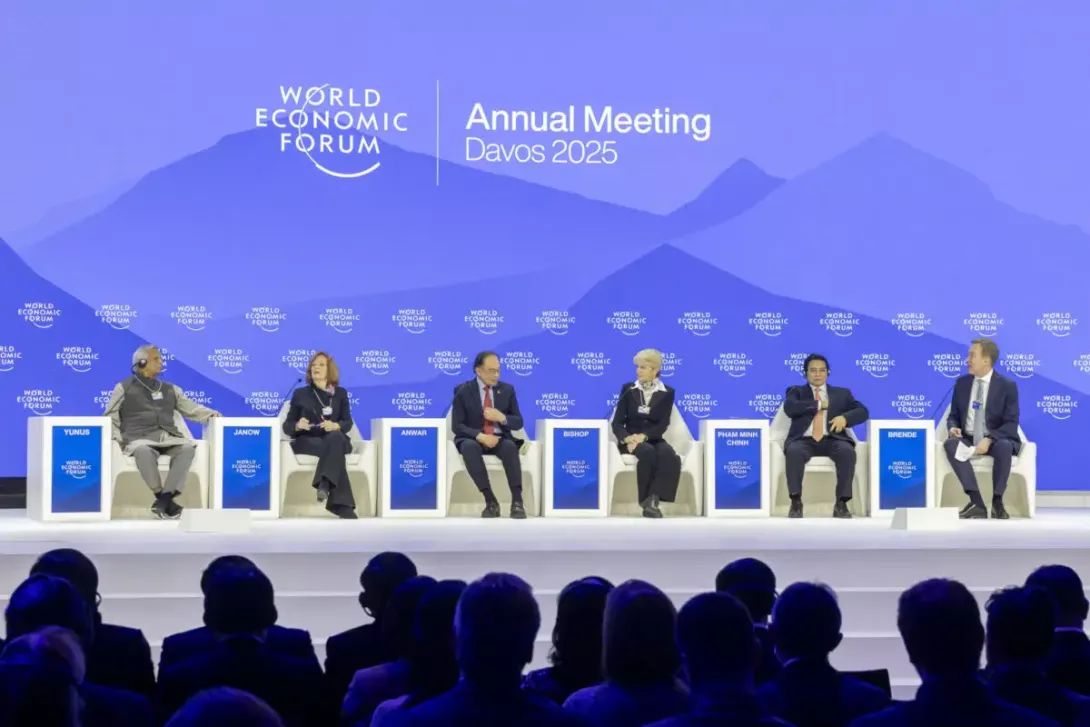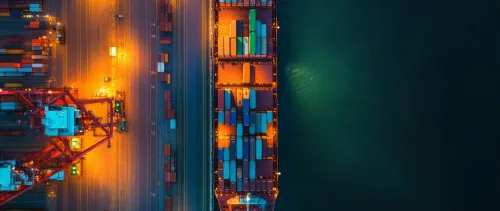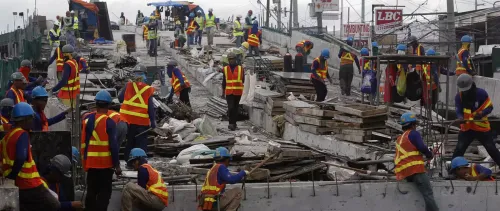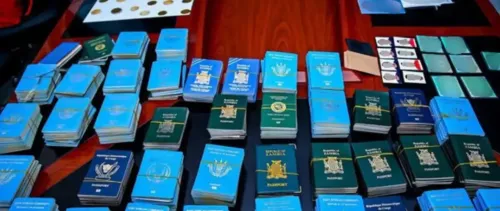
ASEAN: ambitious plans for the bloc. Image: World Economic Forum/Chris Heeney
- ASEAN’s ethos of cooperation and mutual respect looks set to serve as a counterpoint – and respite – to nationalist sentiments and political factiousness that have taken hold in other parts of the world.
- Its focus on peace as the basis on which to develop its economies – individually and collectively – is helping to bring it swiftly into the intelligent age.
- This, and other advantages, ranging from a large, young market to an embrace of the digital economy, offers a conducive environment to investors, leaders said at Davos 2025.
“I think that in an intelligent age, it has to be an age without war. It has to be an age of peace. It has to be an age without conflict. Economically, it has to be an age of comprehensive, inclusive growth.”
Expressing this refreshing sentiment was Pham Minh Chính, Prime Minister of Viet Nam, who spoke in the ASEAN: Stronger Together session at the World Economic Forum’s Annual Meeting in Davos, alongside his Malaysian counterpart, Anwar Ibrahim, and UN Special Envoy of the Secretary-General on Myanmar, Julie Bishop. In doing so, the prime minister encapsulated what is at the heart of ASEAN – the trading and political bloc of South-East Asia – peace, security, collaboration and mutual respect.
Have you read?
6 questions for ASEAN Secretary General Kao Kim Hourn: ‘Diversity is our strength’
What ASEAN offers the world in the Intelligent Age
Attractive investment bloc
ASEAN has long been an attractive investment bloc because of its huge, rapidly developing markets, young, digitally-savvy populations, wealth of natural resources, and a strong cultural identity. In its embrace of the digital age, it has arguably become even more so, and now in an era characterized by geopolitical and trading factiousness, its stability makes it appear a bastion of opportunity.
Its leaders are cognisant of this and used their time at the Annual Meeting to underscore their continued commitment to ASEAN’s core values, as well as their ambitious plans for the bloc. Prime Minister Anwar described relations and trust among the bloc’s leaders as “exemplary” even in areas “deemed to be rather contentious,” revealing that in these instances, discussions take place “in a very frank, friendly manner”.
Expansion, stability and an inclusive approach to tech
The bloc is expanding, with an agreement made in 2024 that Timor-Leste will become its 11th member. The country’s president, José Manuel Ramos Horta, speaking in the session, Navigating Asia’s Hotspots, stated that Timor-Leste will uphold ASEAN’s values, with: “Our first obligation towards our neighbours is to keep the peace in our country.”
Taking advantage of this stable, non-combative basis, the region’s leaders expressed their priorities for the coming year. For Prime Minister Anwar, the focus will be on an “Asean energy grid, alternative technology, energy that covers the whole of former Indochina, Thailand, Malaysia, Singapore, Indonesia, the Philippines and including the undersea cable from Sarawak”. This focus on energy underscores the region’s critical shortfall, which is rising exponentially as the bloc’s economies switch rapidly to digitally-focused economic models.
His second priority is connectivity, and he dispelled the idea of competition, particularly in areas like AI, insisting that ASEAN leaders take an inclusive approach, and “tend to engage and formulate a policy that will benefit one another”.
A region of vitality
Prime Minister Pham Minh Chính listed five areas of strength, but also used his address to urge his ASEAN peers to “have a more ambitious target and a broader vision,” with growth “grounded in science, technology, innovation and digitalization”. For him, ASEAN is a region of “incredible vitality”. He reiterated its advantages and stressed the bloc’s importance to the global economy as well as its long history – and continued experimentation – with “frameworks for integration”, using its current work on a regional digital economic framework agreement (DEFA) as a glowing example in its aim to double the region’s digital economy to $2 trillion by 2030.
DISCOVER
How is the World Economic Forum advancing the digital economy in ASEAN countries?
Show more
Growth opportunities were a key focus during discussions, with Tulsi Naidu, Chief Executive Officer, Asia-Pacific, Zurich Insurance Group, revealing that Asian trade is expected to rise to $7 trillion by 2030. Again, leaders were careful to set the right – and most attractive – tone for their audience. Prime Minister Pham Minh Chính stated: “It would not do to grow alone. We have to grow together.” Among the issues that the premier chose to highlight were the need for better infrastructure, which he described as “a core of growth,” and on which “digitization, science, technology, transportation, society, healthcare and sports” can be grounded.
Skills and education
The need for a better-quality workforce was stressed, including a push for more young people to go into higher education. Again, ASEAN’s cultural values were stressed, with Muhammad Yunus, Chief Adviser to the Bangladeshi government and long-time collaborator with the bloc, suggesting that in pursuing education: “It will be something in part for yourself and part for the community, the society that you belong to, so that society becomes a better society after what you have done.”
Chief Adviser Bangladesh Government Muhammad Yunus. Image: REUTERS/Yves Herman
“(Education) will be something in part for yourself and part for the community, the society that you belong to, so that society becomes a better society after what you have done.
”
— Chief Adviser Bangladesh Government Muhammad Yunus.
A bridge between China and the US?
Having provided a robust picture of ASEAN’s internal strengths, attention turned to what the bloc can achieve globally, and here its conciliatory and impartial approach, in which it makes a policy of not commenting on the internal politics of other states, was touted as of potential value. One area of focus that was highlighted was ASEAN’s potential to act as a “bridge” in relations between China and the US. President José Manuel Ramos Hortaspoke of this as being the “best role” for the bloc, and revealed his admiration for the diplomatic efforts of Indonesia’s Prabowo Subianto Djojohadikusumo, who he described as an internationalist well suited to this task.
An elusive peace plan for Myanmar
Considering bridge building closer to home, the spotlight shifted to the question of member state, Myanmar. Pragmatic is the best description – and one offered by Prime Minister Anwar – for ASEAN’s attitude towards Myanmar. Civil unrest has ravaged the country, which is also dogged by revelations of human rights abuses, and since 2021, the resumption of military rule. It doesn’t fit ASEAN’s model or ethos and that’s a problem for the bloc. ASEAN leaders put together a peace plan for Myanmar in 2021, but talks with the ruling junta have remained elusive.
Under the gaze of the international community, ASEAN leaders stressed the need for trust building and consensus, suggesting that progress is being made, while Julie Bishop, suggested that the bloc’s “influence to get a better outcome for the people of Myanmar,” and stressed that the UN continues to partner with the bloc in its attempts to help reach a solution.
The comments from this Annual Meeting offered the sense that ASEAN has the potential to offer the global community a great deal in the coming year. Its stability and impartial outlook will undoubtedly prove attracting to investors against such a troubled geopolitical and economic landscape. As Ferdinand Martin G. Romualdez, Speaker of the House of Representatives in the Philippines, put it, “it will maintain that peace and prosperity and stability that we all seek.” Concurrently, however, significant challenges remain and how the bloc’s leaders tackle these – individually and collectively – will set the tone not just for 2025 but for years to come.


